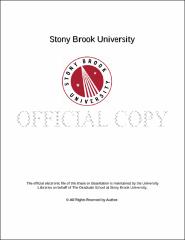| dc.identifier.uri | http://hdl.handle.net/11401/76937 | |
| dc.description.sponsorship | This work is sponsored by the Stony Brook University Graduate School in compliance with the requirements for completion of degree. | en_US |
| dc.format | Monograph | |
| dc.format.medium | Electronic Resource | en_US |
| dc.language.iso | en_US | |
| dc.publisher | The Graduate School, Stony Brook University: Stony Brook, NY. | |
| dc.type | Thesis | |
| dcterms.abstract | <italic>trans</italic>-translation is a quality control mechanism used by bacteria to rescue ribosomes stalled on aberrant mRNAs. The major contributors to this salvage mechanism are SmpB (Small Protein B) and tmRNA (transfer messenger RNA). The SmpB-tmRNA complex recognizes and binds stalled ribosomes. As a result, it helps release the stalled ribosomes while simultaneously marking the incomplete polypeptide for proteolysis by adding a degradation tag to its C-terminus. The SmpB protein has a C-terminal tail that is disordered in solution and is known to play an important role during <italic>trans</italic>-translation. I have incorporated several independent mutations into the corresponding region of the smpB gene that should enable in vivo UV crosslinking and identification of interacting partners of SmpB during various stages of the <italic>trans</italic>-translation process. During <italic>trans</italic>-translation, the defective mRNA that causes ribosome stalling is targeted for degradation by the 3´-5´ exoribonuclease RNase R. RNase R has two distinct domains that are not present in other related exoribonucleases in the cell. An N-terminal domain that contains a helix-turn-helix motif of unknown function, and a C-terminal domain that is important for <italic>trans</italic>-translation dependent degradation of the defective mRNA. RNase R is also involved in general RNA turnover in the cell. Recently, RNase R has been shown to associate with the RNA degradosome during stationary phase. I have investigated which of the two unique domains of RNase R play a role in its association with the degradosome. Based on the results, I have demonstrated that the N-terminal domain of RNase R is not required for this process. | |
| dcterms.abstract | <italic>trans</italic>-translation is a quality control mechanism used by bacteria to rescue ribosomes stalled on aberrant mRNAs. The major contributors to this salvage mechanism are SmpB (Small Protein B) and tmRNA (transfer messenger RNA). The SmpB-tmRNA complex recognizes and binds stalled ribosomes. As a result, it helps release the stalled ribosomes while simultaneously marking the incomplete polypeptide for proteolysis by adding a degradation tag to its C-terminus. The SmpB protein has a C-terminal tail that is disordered in solution and is known to play an important role during <italic>trans</italic>-translation. I have incorporated several independent mutations into the corresponding region of the smpB gene that should enable in vivo UV crosslinking and identification of interacting partners of SmpB during various stages of the <italic>trans</italic>-translation process. During <italic>trans</italic>-translation, the defective mRNA that causes ribosome stalling is targeted for degradation by the 3´-5´ exoribonuclease RNase R. RNase R has two distinct domains that are not present in other related exoribonucleases in the cell. An N-terminal domain that contains a helix-turn-helix motif of unknown function, and a C-terminal domain that is important for <italic>trans</italic>-translation dependent degradation of the defective mRNA. RNase R is also involved in general RNA turnover in the cell. Recently, RNase R has been shown to associate with the RNA degradosome during stationary phase. I have investigated which of the two unique domains of RNase R play a role in its association with the degradosome. Based on the results, I have demonstrated that the N-terminal domain of RNase R is not required for this process. | |
| dcterms.available | 2017-09-20T16:51:28Z | |
| dcterms.contributor | Karzai, A. Wali | en_US |
| dcterms.creator | Zafar, Hina | |
| dcterms.dateAccepted | 2017-09-20T16:51:28Z | |
| dcterms.dateSubmitted | 2017-09-20T16:51:28Z | |
| dcterms.description | Department of Biochemistry and Cell Biology. | en_US |
| dcterms.extent | 56 pg. | en_US |
| dcterms.format | Application/PDF | en_US |
| dcterms.format | Monograph | |
| dcterms.identifier | http://hdl.handle.net/11401/76937 | |
| dcterms.issued | 2015-08-01 | |
| dcterms.language | en_US | |
| dcterms.provenance | Made available in DSpace on 2017-09-20T16:51:28Z (GMT). No. of bitstreams: 1
Zafar_grad.sunysb_0771M_11425.pdf: 1894366 bytes, checksum: 1edf7108f31c573b15082b6302609edf (MD5)
Previous issue date: 2013 | en |
| dcterms.publisher | The Graduate School, Stony Brook University: Stony Brook, NY. | |
| dcterms.subject | Biochemistry | |
| dcterms.title | Biochemical Analysis of SmpB and RNase R in RNA Quality Control Mechanisms | |
| dcterms.type | Thesis | |

